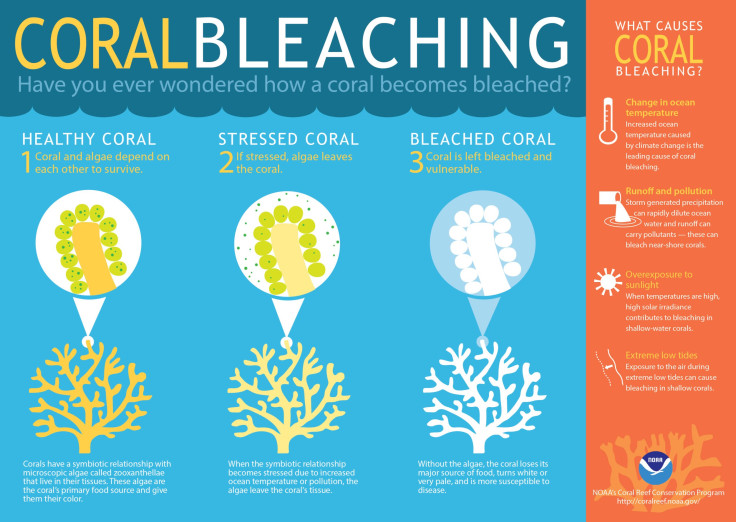Coral Reef Bleaching: How Climate Change Threatens Marine Ecosystems

As global temperatures rise and our oceans heat up, we can expect more and more bleaching to occur at coral reefs around the world. But what are coral reefs and why are they important? And what does it mean when scientists say they are bleaching?
Coral reefs are a hard, rocky material that forms as a byproduct of the life processes of corals, organisms that live together in enormous marine communities. These reefs grow just a few centimeters each year, the U.S. National Ocean Service says, so it has taken a long time for the biggest ones to reach their massive size.
“It can take up to 10,000 years for a coral reef to form from a group of larvae,” the organization says. “Depending on their size, barrier reefs and atolls can take from 100,000 to 30 million years to fully form.”
Reefs are classified as a barrier or an atoll depending on their formation. Barrier reefs circle the shoreline of a landmass but are a certain distance from the land, while atolls have no visible land enclosed within them because it has become submerged.
All sorts of creatures work together to make a coral reef the special place it is. Scientists and divers can spot fish, sponges, crustaceans, turtles, algae and tons of other species, large and small, that find shelter and food at coral reefs.
“In addition to being some of the most beautiful and biologically diverse habitats in the ocean, barrier reefs and atolls also are some of the oldest,” the National Ocean Service says.
But these reefs are in danger. Coral reefs bleach as oceans get warmer — expelling the algae living inside them and turning white. In this state, they are more vulnerable to disease.
“When a coral bleaches, it is not dead,” the ocean service explains. “Corals can survive a bleaching event, but they are under more stress and are subject to mortality.”

The world’s largest reefs around the world have suffered enormous bleaching events in recent years, and although other factors can play a role in coral bleaching, experts say climate change will only make matters worse in the future.
The International Union for Conservation of Nature declared on Monday at the UN’s climate change conference in Germany that climate change is the fastest growing threat to natural World Heritage sites around the world like national parks, wetlands, forests and glaciers, and it listed coral reefs as being among the most at risk. The group’s report says that 62 of the 241 natural World Heritage locations are in danger from climate change — almost double the number in danger when this research was last completed in 2014 and now representing about a quarter of these sites.
There are also a number of cultural World Heritage sites.
The IUCN report lists all the natural sites and their level of endangerment, as well as the top sources of threats. Climate change is now second on the list of threats, after invasive non-native species, which can force native species to local extinction and upset the ecological balance of an area.
Coral reefs and glaciers are “the most threatened ecosystems,” the IUCN said.
Other top threats include tourism, hunting, fire, fishing, water pollution, logging, poaching, war and infrastructure like roads and housing. There are also more natural threats on the list, such as earthquakes and tsunamis.
Although invasive species, tourism and expanding infrastructure are also increasing in their danger to natural heritage sites, the threat of climate change is currently growing more quickly. Tourism and hunting, for example, affected more sites than climate change when the 2014 report was released. And climate change is swiftly gaining on the No. 1 threat of invasive species.
“Protection of World Heritage sites is an international responsibility of the same governments that have signed up to the Paris Agreement,” IUCN Director General Inger Andersen said in a statement, referring to the pact countries have made to reduce greenhouse gas emissions as an effort to mitigate climate change. “Climate change acts fast and is not sparing the finest treasures of our planet.”
BREAKING NEWS: Number of natural #WorldHeritage sites affected by climate change nearly doubles in 3 years, IUCN report https://t.co/Pk9GUkmchh #COP23 @IUCN_PA pic.twitter.com/tfouxap88E
© Copyright IBTimes 2024. All rights reserved.











